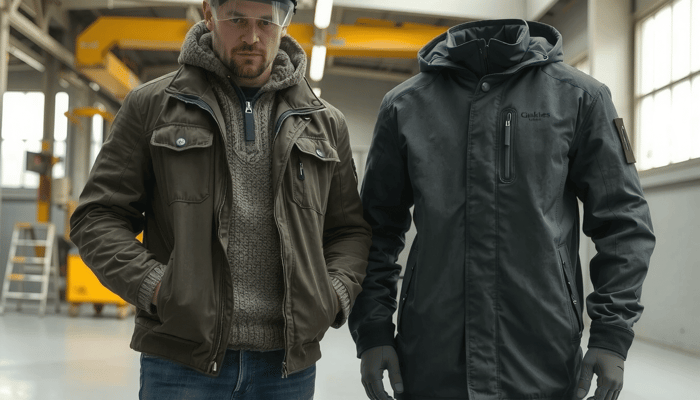Jacket vs. Coat: The Definitive Guide to Choosing the Right Outerwear
 Mr. Eton Yip | 32+ Year Garment Manufacturing Expert & Founder of Eton Garment
Garment Industry
Mr. Eton Yip | 32+ Year Garment Manufacturing Expert & Founder of Eton Garment
Garment Industry
July 20th, 2025
9 minute read
Table of Contents
- Introduction: More Than Just a Name
- The Core Differences: Jacket vs. Coat at a Glance
- The Ultimate Comparison: A Detailed Breakdown
- A Closer Look: Iconic Styles of Jackets and Coats
- A Practical Guide: When to Wear a Jacket vs. a Coat
- Clearing the Confusion: What About Parkas, Blazers, and "Shackets"?
- A Note on Quality and Care
- Frequently Asked Questions (FAQ)
- FAQs
Introduction: More Than Just a Name
The terms "jacket" and "coat" are frequently confused by people who think of them as synonyms. But the reality is, they aren't synonyms. In the world of clothing, these are two distinct types of outerwear. By knowing this difference, you can easily put together a wardrobe that will always work and look good.
The differences are easy to understand. The main focus is on length, fabric, and function. A jacket is not simply a shorter coat. A coat is not merely a longer jacket. Each of them has a special role to play, depending on the weather, the occasion, and your personal style.
This guide answers the question: jacket or coat? When you're done reading, you'll have a clear idea of what to wear in any circumstance.

The Core Differences: Jacket vs. Coat at a Glance
Do you want a fast answer? The main differences are easy to spot. The jacket versus coat dispute mostly boils down to a few vital features.
This is what constitutes a jacket:
- Length: shorter, generally coming to your waist or hips
- Material: lighter materials are mainly used
- Weather: spring, fall, or inside as a style layer
- Style: usually more casual
This is what constitutes a coat:
- Length: longer, from mid-thigh to ankle
- Material: heavier to provide better insulation
- Purpose: constructed specifically to fight against cold winter weather
- Style: can be either casual or very formal
These simple explanations give an idea of what are the key differences between a coat and a jacket. Design and function are the two most important elements.
The Ultimate Comparison: A Detailed Breakdown
To understand what is difference between jacket and coat, a side-by-side observation is a good technique. This chart shows the main differences between the two clothing types. It can be a helping hand while you build your perfect closet.
| Feature | Jacket | Coat |
|---|---|---|
| Length | Waist or hip-length. Designed for mobility and less coverage. | Thigh, knee, or full-length. Designed for maximum coverage and warmth. |
| Weight & Insulation | Lighter materials like denim, leather, nylon, or cotton. Minimal to light insulation. | Heavier materials like wool, down, heavy synthetics, or fur. Significant insulation. |
| Primary Season | Spring, Autumn, cool summer evenings. | Winter, deep autumn. |
| Typical Occasion | Casual, smart-casual, layering piece for style. | Formal, business, protection from severe weather. |
| Common Styles | Bomber, Denim Jacket, Blazer, Leather Jacket, Windbreaker. | Trench Coat, Peacoat, Overcoat, Parka, Duffle Coat. |

This visual representation makes choosing between these two essential types of outerwear easy.
A Closer Look: Iconic Styles of Jackets and Coats
To be very clear, it helps to look at authentic examples. Here are classic styles and reasons why they qualify as either jackets or coats.
Classic Jacket Styles Explained
- The Denim Jacket: This timeless piece stops at the hip and has no insulation. It's made for style and light protection in nice weather. That makes it a perfect example of a jacket.
- The Bomber Jacket: These were first worn by pilots. They are waist-length and have ribbed cuffs and hem. They have light insulation - more warmth than a windbreaker but much less than a winter coat. This puts them clearly in the jacket category.
- The Leather Biker Jacket: Leather is a heavy material, but this jacket's short, waist-length cut defines it. It blocks wind well but doesn't have the length and heavy insulation of a real coat.
Timeless Coat Styles Explained

- The Trench Coat: This famous garment is knee-length or longer. It is made from water-resistant cotton gabardine. Its length and protective material make it a coat. It's intended for rainy, in-between weather rather than deep cold.
- The Peacoat: This traditional style runs from hip to thigh and is made of heavy naval wool. The thick material and length ensure the wearer is warm. This clearly places it in the coat category as a winter essential.
- The Overcoat: As the name suggests, this is a long coat worn over a suit or other clothes. It often goes down to the knee. Classy materials like wool or cashmere make it the ultimate cold-weather coat for business or formal events.
A Practical Guide: When to Wear a Jacket vs. a Coat
Let's move beyond theory and look at the application. From our experience in garment design and styling, the right choice means matching your outerwear to the environment and the situation.
For a Crisp Autumn Day Trip
A cool autumn day needs layering, not heavy insulation. This is an ideal time for a jacket.
Recommendation: A stylish leather jacket or versatile denim jacket. Why: These pieces protect you from a cool breeze without making you too hot during a walk or while sitting in a sunny café. A full-length coat would feel awkward and be too much. A jacket lets you move comfortably and layer easily over a sweater.
For a Formal Winter Wedding or Business Meeting
Dressing for a formal event in the cold requires both warmth and proper etiquette. This is when you should wear a coat.
Recommendation: A classic wool overcoat. Why: Here, length is the important consideration. It must be long enough to completely cover a suit jacket or the hem of a formal dress. Thick wool will keep you warm. The tailored shape keeps you looking professional and elegant. This shows you understand the difference between formal clothing and casual wear. A casual bomber jacket would simply be out of the question.
For a Rainy Spring Commute
Mild but wet weather creates a unique challenge. You need protection from rain without the heavy insulation of winter wear.
Recommendation: A lightweight trench coat. Why: The trench coat is the perfect solution. Its length keeps your legs dry from splashes. Its water-resistant fabric helps keep you dry. Because it's often unlined or lightly lined, it won't make you too hot on a milder spring day. This makes it much more practical than a heavy winter parka.

Clearing the Confusion: What About Parkas, Blazers, and "Shackets"?
The lines between different outerwear can get muddy, particularly with modern fashion trends. Here we address some common points of confusion.
Is a Parka a coat or a jacket? A parka is definitely a type of coat. It's known for its length (usually mid-thigh or longer), heavy insulation, and hood. It's built for severe cold, meeting every requirement for a coat.
What about a Suit Jacket? A suit jacket, or blazer, is technically a jacket based on its waist-length cut. However, it's not outerwear. It's part of an indoor outfit. You would wear a coat over it for warmth when outside.
The Rise of Hybrids Modern clothes like the "shacket" (shirt-jacket) intentionally blur the lines. These hybrids combine the weight of a light jacket with shirt styling. Even so, the basic principles still help categorize them. Fashion historians note how terms have always adapted from historical garments like cloaks and surcoats. This leads to the variety we see today.
A Note on Quality and Care
Whether you are acquiring a timeless coat or a versatile jacket, how long it lasts will depend on its quality and the care you take. Always follow the care label instructions for cleaning and storage.
Superior construction and high-quality materials are the foundation of a garment that will last for many seasons. For those looking to create a custom line or personal wardrobe staple, working with reputable garment makers ensures you get a piece that is both stylish and built to last.
Frequently Asked Questions (FAQ)
To further clarify the difference between a jacket and a coat, here are answers to common questions.
Can a jacket be warmer than a coat?
Yes, in specific cases. A highly technical, down-filled ski jacket can be much warmer than a lightweight, unlined trench coat. But when comparing garments with a similar purpose, a winter coat is almost always warmer than a winter jacket. This is because of its greater length and insulation.
What is the main difference between a jacket and a coat in the UK vs. the US?
The terminology is mostly the same. In both American and British English, "coat" means a longer, heavier garment for cold weather, while "jacket" means a shorter, lighter one. Some minor regional slang may exist, but the fundamental distinction between a jacket and a coat is unchanged.
Is a blazer considered a jacket?
Yes, a blazer is a type of jacket. It's defined by its shorter length and tailored fit. However, it works as part of a smart-casual or business outfit. It is not meant as functional outerwear for harsh weather. In cold conditions, you would wear a coat over your blazer.
Do you wear a coat or a jacket with a dress?
This depends entirely on how formal the dress is and the weather. For a formal event in winter, a long wool coat, such as an overcoat or a chic wrap coat, is the best choice. For a casual dress on a cool summer evening, a denim or leather jacket provides a stylish, modern look.
What is a "car coat"?
A car coat is a specific style of coat that usually ends at mid-thigh. It was originally designed in the early 20th century to provide warmth while being short enough for comfortable driving. It perfectly shows the nuance in outerwear. While shorter than an overcoat, its purpose and length firmly place it in the coat category. For those interested in classic designs like this, exploring options from established reputable garment makers can provide insight into quality construction.
Related Articles
How to Wear a Denim Jacket: Complete Style Guide for 2025
12 minute read
July 20th, 2025
The denim jacket is undoubtedly a classic. This piece of clothing has long represented the simplicity... more »
Restoring a Stinky Leather Jacket: All You Need To Know To Remove Any Odor From a Leather Jacket
10 minute read
July 20th, 2025
You pull your favorite leather jacket from the closet, excited to wear it. But then an undesirable... more »
How Should a Jean Jacket Fit? The Ultimate Guide to a Perfect Look
8 minute read
July 20th, 2025
A well-fitting jean jacket is more than clothing. It's a timeless wardrobe essential that brings... more »
From Fabric to Finished: Your Ultimate Guide on How to Sew a Jacket
10 minute read
July 20th, 2025
Making a first-time jacket is a big milestone in sewing. It is the thing that differentiates the casual... more »
Is Wearing Leather Jackets Warm? Comprehensive Guide to Style & Weather Comfort
11 minute read
July 21st, 2025
Yes, leather jackets are warm indeed. However, the level of warmth considerably fluctuates. A thin... more »

